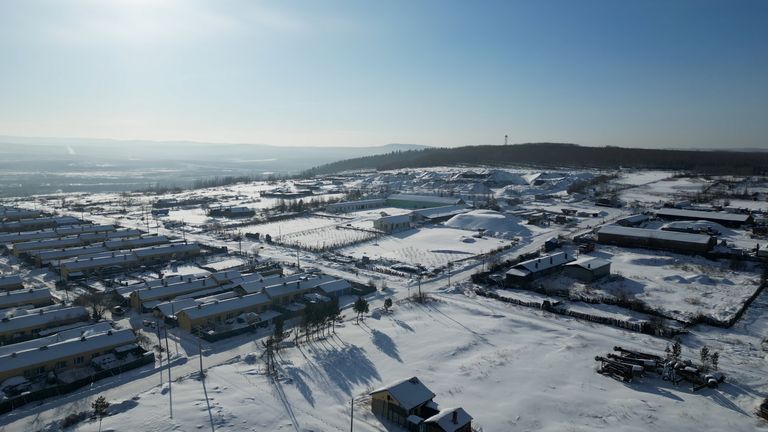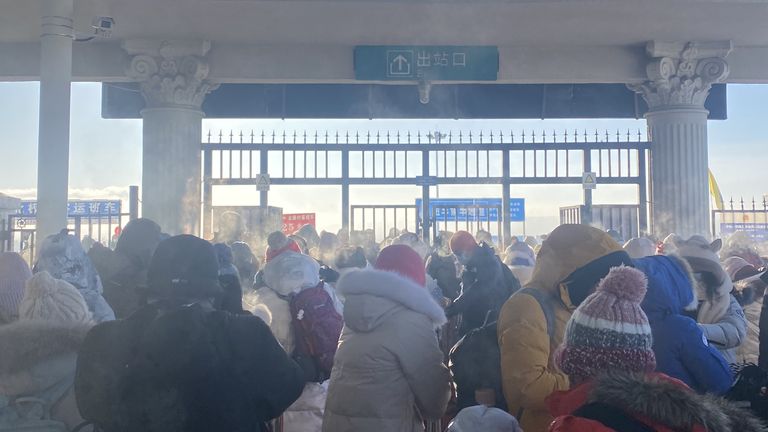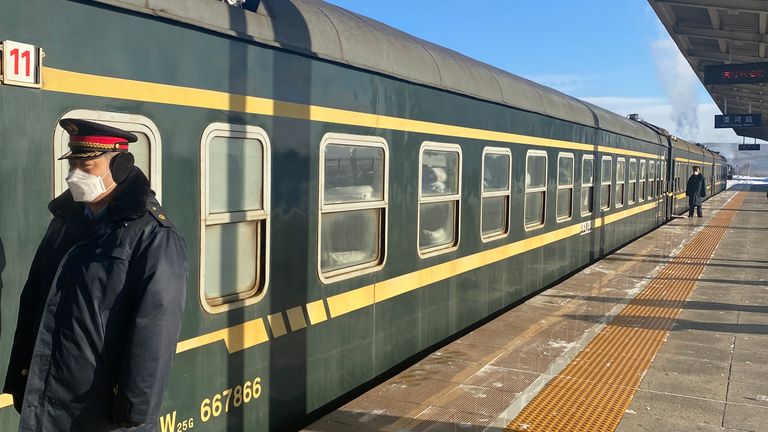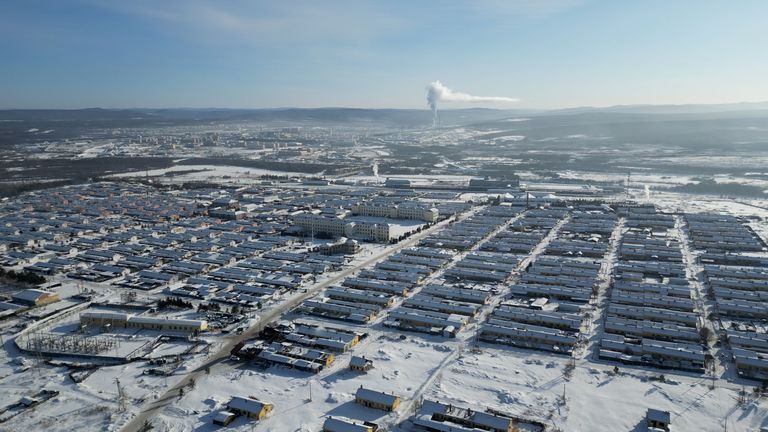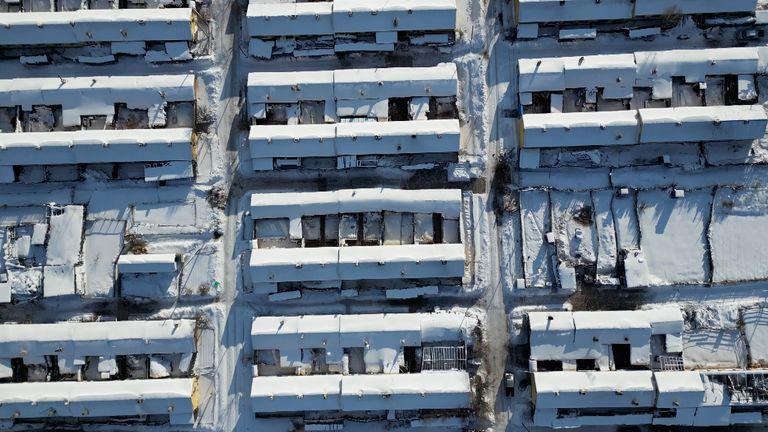Mohe is known as China’s North Pole for a good reason. It is the country’s most northern city and is a very, very cold place.
It’s difficult to describe what temperatures this low feel like.
On Sunday it hit -53C, a new low for the coldest temperature recorded in the country since modern monitoring began.
The National Meteorological Centre confirmed the previous record of -52.3C, set in 1969, had been beaten.
It’s so cold that the air catches in your throat, it feels uncomfortable in your lungs and you almost feel like you need to cough it out.
There is a strange freezing sensation around any part of your body where moisture lingers.
You feel a kind of instant hardening around your eyelids and in your nostrils.
If your fingers are exposed, even if you’re just wearing thinner gloves, they’ll be totally numb in a matter of minutes – frostbite is a very real risk here.
Batteries on our devices drained abnormally quickly.
We had to ensure we only spent a short time outside at any one time and always had a warm vehicle to retreat to.
But there are fun bits too. A cup of boiling water thrown in the air freezes almost instantly and crashes to the ground as frozen globules of ice.
It’s one of the reasons Chinese tourists flock here.
Mohe is located on the top tip of a slimmer section of China that protrudes right up into Russia – it’s surrounded by Russia from the north, east and west and is often exposed to harsh air travelling south from Siberia.
It’s around 1,500 miles north of Beijing, which is already considered pretty far north.
It’s a picturesque, snow-covered place, home to about 85,000 residents who work in industries from farming to tourism.
Some homes are modern and well-equipped, but others are old-fashioned, heated with small coal burners.
Local heating companies in Mohe have said the boilers are running at full power to help people through the winter and Beijing News reported that coal consumption has increased by a third in the city.
While extreme temperatures are not unusual here, they are around 15C to 20C lower than the average. It raises now-familiar questions about the increased frequency of extreme weather events and what’s causing it.
Part tourist town, part frontier outpost
An hour’s drive further north is the village of Beiji.
It’s an odd place that you need to buy a ticket to enter, and feels like part tourist town, part frontier outpost.
Aside from its name literally translating to “north pole”, one of Beiji’s main attractions is the view over to its neighbour.
Across a vast frozen river, a fence lines the border, and beyond you can see the rocky hills of Russia.
Getting to Mohe is something of an undertaking
You get a sense that you’re going somewhere very bleak and very remote as soon as you board the sleeper train.
It’s an old, rickety, characterful thing. The sleeping bunks are all open to the corridor – six people, stacked three on three in each little space.
Around the windows, the condensation forms a thick ice lining, hours before we reach our destination, outside the snow-drenched scenery is sublime.
Tourists are mixed with more hardened locals here – we were travelling during the Chinese Lunar New Year holiday and it was packed.
This 15-hour train was the last leg of the journey. We’d had to first fly two hours north from Beijing and then take a series of other trains to reach this one. It gives you a sense of just how remote and far north Mohe is.
‘You can’t fight against heaven’
It is often very, very cold here, so there is a degree to which the locals are hardened to it and expect it. They joke that tourists come here totally unprepared for what they find.
Mr Xie runs a small convenience store and gift shop literally overlooking the Russian border. Inside, among his wares for sale, is a small bed, a stove and a wood burner to keep him warm.
We asked him what it was like at -53C.
He said: “There is smoke. You can’t see anyone from a couple of metres away. Until noon, the smoke – we call it smoke but it’s actually really heavy fog – went away. Smoke appears whenever it gets cold.
“You can’t fight against heaven. All we can do is to take whatever measures we can. As long as we are not cold, it’s fine.”
But are you not worried, we asked.
“Worried, but not much we can do. Humans can’t defeat natural disasters. Countries can’t defeat natural disasters, let alone individuals. No method,” he said.
A cold spell from Siberia
This cold spell is being caused by an area of very cold low-pressure air moving south from Siberia. The land there is so far from the warming effects of the sea and gets so little sunshine that the conditions are perfect for the creation of extra cold air.
Normally the circulation of this air is limited by local wind patterns, but “weakness” in the system can cause the freezing air to break out as it did during the “Beast from the East” across Britain in 2018.
But even up in Russian Siberia, they have been experiencing more frequently aggressive cold spells.
The role of climate change
While you can’t attribute any individual event directly to climate change without further research, it is certainly true that this part of the world is now experiencing more extreme weather events more frequently.
Research suggests that climate change can be responsible for excessively cold spells.
For instance, scientists think that warming seas in the Arctic areas north of Russia can have a destabilising effect on the air in the stratosphere, the body of air between 10km and 50km above the world’s surface.
This, they say, can cause excessive cold spells in more low-lying areas.
China’s weather extremes
The weather in China has been a story of historic extremes in the past six to eight months.
In the summer, the country was hit by record periods of heat and drought that authorities described as the “most severe” since records began in terms of duration, intensity, and impact.
It was, in fact, the hottest summer and autumn in 60 years, with multiple cities breaking records. The average rainfall fell by 23% and the country suffered serious forest fires, damaged crops and reduced power supplies.
Swathes of the Yangtze River dried up, affecting industries from hydropower to shipping.
China, though one of the world’s leading investors in clean energy, still relies on an extensive coal mining industry and is a major contributor to the world’s greenhouse gas emissions.
While many Chinese people are just getting on with their lives, others, particularly those who have experienced these extreme weather events, say they have noticed changes and are concerned about them.
This is a country of 1.4 billion people with an incredibly vast range of topographies and climates.
Big ranges in weather are expected and normal here, but such historic extremes in such quick succession are, as some say, concerning.

